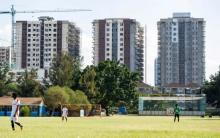News
Meet CityMetrics: An Open-Source, Interactive Tool for Analyzing Urban Risks and Opportunities
With CityMetrics, a new geospatial data platform developed by WRI, over 60 cities--including all 23 UrbanShift cities--can access in-depth data on urban risks and vulnerabilities.
A street view of Mexico City. CityMetrics’ data shows that proximity to open spaces is lower for Mexico City’s children (53.2%) compared to the population as a whole (55.4%). Photo: Irving Trejo/Unsplash
Which neighborhoods are suffering the most from rising urban heat? Where is flooding the biggest challenge? What other cities around the world are struggling with air pollution, and what can we learn from those that have improved the quality of their air in recent years?
If you work in or around cities, these—and many more—are all questions that have likely crossed your mind. A new tool created by WRI Ross Center aims to equip cities with an accessible way to answer them.
CityMetrics is a robust, open-source and interactive dashboard that provides comprehensive data on climate, environmental and spatial risks (and opportunities) for more than 60 cities around the world. Organized around seven key resilience themes—accessibility, air quality, biodiversity, climate mitigation, flooding, heat, and land protection and restoration—the dashboard enables users to compare data on more than 40 indicators within and between major global cities.

Cities are eager to identify and pursue solutions to their most pressing challenges. But understanding which issues are most acute for cities and which interventions could deliver the most meaningful impact is more complex than it may seem.
While data innovations are vastly expanding the information available about nearly every city in the world, this vital information is not necessarily easily accessible or actionable for decision-makers in smaller or poorer cities, especially those cities in the Global South.
With CityMetrics, WRI Ross Center aims to close the data and information gap for cities and create visibility into the severity of challenges in specific places so cities can prioritize actions and anticipate the efficacy of potential solutions. Providing cities with a high-level overview of where they stand on a range of indicators—from the percent of built-up land without tree cover to the average exposure to PM 2.5 pollution—can help cities to understand where attention and action is needed most.
With this tool, cities can see how they stack up against others with similar social and geographic profiles. By comparing performance across key indicators, cities can use insights to shape their budgets and long-term plans.

CityMetrics is the evolution of a previous platform, the Cities Indicators Dashboard, which was launched in 2023 with data on over 30 cities within the UrbanShift and Cities4Forests networks. In recognition of the value that this kind of open-source and actionable data provides to cities, WRI Ross Center’s Urban Analytics and Data Innovation team expanded the tool to include a wider range of cities and incorporated several new features to deepen analysis.
The dashboard now features time-series data for many indicators to enable assessment of trends over time within a city, alongside disaggregation of several key indicators by population group to facilitate deeper understanding of social equity factors. Additionally, the dashboard now includes expanded and improved accessibility metrics that measure access to core urban services so cities can better understand residents’ needs.
The extensive data available in CityMetrics has already been used by cities to inform their strategies and resilience planning:
- In Kigali, Rwanda, geospatial data played a key role in enabling the city to assess the resilience and connectivity of a new planned development called Nunga. Through an UrbanShift geospatial planning analysis lab, city stakeholders analyzed data on Nunga’s vulnerability to climate risks and assessed how effectively public transit systems served the new development. With these insights, city stakeholders were able to identify solutions to strengthen plans for Nunga.
- Costa Rica is renowned for its natural areas and biodiversity—and the country wants to ensure that its urban areas benefit from nature, too. Using geospatial data, stakeholders assessed the biodiversity and habitat connectivity within the San José metropolitan area and identified opportunities to integrate more tree cover and green spaces even within urban features like new transit hubs.
- As Marrakech, Morocco, grapples with mounting extreme heat, the city identified green spaces as critical to combatting rising temperatures and improving quality of life. Through an UrbanShift geospatial planning lab, stakeholders used the data to inventory Marrakech’s existing green spaces and identify opportunities for expansion. The city is now focused on expanding nature into underserved and more built-up areas, while also creating a stewardship strategy for its green spaces.

Beyond these examples of how the geospatial data within the CityMetrics dashboard is already driving more sustainable planning, the 60 cities currently featured in the tool will be able to explore and derive even more insights that can inform resilient decision-making. For instance, with CityMetrics we’ve learned that:
- In Mexico City, Mexico, proximity to open spaces is lower for children (compared to the population as a whole), with 53.2% of children having access to open space within a 300-meter walking distance, compared to 55.4% for the population as whole and 58.7% of the elderly.
- Kampala, Uganda, has well above the average concentration of PM2.5 air pollution compared to other cities of its size. Other large cities in the region, including Addis Ababa and Freetown, also have high pollution levels closer to the median, while Nairobi is below the median, but still above WHO recommended levels.
- In Freetown, Sierra Leone, Wards 402, 403, 430 and 422 have the highest shares of built-up land near natural drainage of all wards in the city, putting them at high risk for floods. The first three wards include large areas of irregular settlements, and the final one is dominated by a seaport.
- Nairobi, Kenya, is projected to see the number of heat waves more than double between the 2020s and 2060s. The city also has among the highest share of built land with low surface reflectivity, which further exacerbates its growing heat challenges. But the data also reveals a solution: by identifying the areas of the city with the lowest surface reflectivity, it simultaneously highlights where cities need to add heat-resilient infrastructure, like cool roofs, to help cool down.

Detailed insights like these can prompt cities to take action to address disparities in vulnerabilities or point them to examples of peer cities that they can connect with for ideas and solutions. Cities are facing both intensifying and broadening climate risks. As the urgency for action rises, it’s more critical than ever that cities fully understand the scope of their vulnerabilities—and which solutions could achieve the greatest impact.
With CityMetrics, cities around the world can gain a clear, nuanced and actionable lens on their unique risks, and consider data-informed solutions that can inspire worldwide action.
Eric Mackres is Data & Tools Senior Manager at WRI Ross Center for Sustainable Cities.
Pablo Lazo is Urban Development Director at WRI Ross Center for Sustainable Cities
Eillie Anzilotti is Urban Development Communications Manager & UrbanShift Communications Lead at WRI Ross Center for Sustainable Cities.
Saif Shabou is Urban Analytics Product Manager at WRI Ross Center for Sustainable Cities.
Ted Wong is Data & Tools Research & Project Associate at WRI Ross Center for Sustainable Cities.

Building connections to support sustainability across the world's cities
How UrbanShift is supporting the goals of a range of global initiatives for climate action and sustainability.

How Teresina is Accelerating its Transition to a Green and Resilient City
From UrbanShift's capacity-building activities, this scorching city in northeastern Brazil is drawing inspiration and technical knowledge to build sustainability from the ground up.

UrbanShift Annual Report Launch Webinar: Reflecting on 5 Years of Impact
This webinar will highlight voices from around the UrbanShift network and spotlight stories of sustainable urban transformation.

Resilient Infrastructure in Brazil's Cities Grows from the Roots
How cities from Recife to Belém are pursuing innovative green strategies with the support of the Global Environment Facility.

